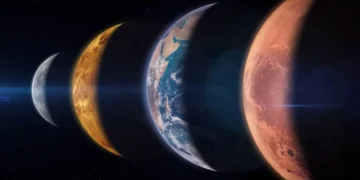For the remainder of February, stargazers have a rare opportunity to witness an extraordinary celestial event—a planetary alignment featuring all seven of our solar system’s planets visible at the same time. Mercury, Venus, Mars, Jupiter, Saturn, Neptune, and Uranus will make an appearance in the night sky, offering a breathtaking spectacle.
What Is a Planetary Alignment?
A planetary alignment is when multiple planets appear to form a line in the sky from our vantage point on Earth. However, this doesn’t mean the planets are actually lined up in space.
Understanding the Ecliptic Path
The planets orbit the Sun on a relatively flat plane called the ecliptic plane. As Earth moves through its orbit, it sometimes reaches a position where multiple planets appear grouped together along this plane. This is why, during alignments, the planets seem to form a curved line in the night sky.
Astrophysicist Emily Elizondo from Michigan State University explains that while planets may look like they’re in a straight row from Earth’s perspective, they are actually scattered across vast distances in space.
How Rare Is This Planet Parade?
While alignments of three or four planets are fairly common, a seven-planet alignment is significantly rarer. According to Elizondo, these large-scale alignments occur every few years but not always with this many planets visible at once.
Each planet has a unique orbital period, meaning they take different amounts of time to complete one trip around the Sun. Because of this, large alignments only happen when multiple planets happen to be on the same side of the Sun relative to Earth.
When and Where to See the Planet Alignment
This spectacular celestial event will be visible through the end of February, with the best time to view it being 90 minutes after sunset.
Where to Look in the Sky
- Southwest: Mercury and Saturn
- Southeast: Mars and Jupiter
- Between These Regions: Venus, Neptune, and Uranus
Since planets shine steadily (unlike stars, which twinkle), they are relatively easy to distinguish in the sky. However, using a stargazing app can help locate the planets more precisely.
Which Planets Are the Easiest to Spot?
Not all seven planets will be equally easy to see with the naked eye.
- Venus is the brightest and easiest to spot due to its proximity to Earth and highly reflective cloud cover.
- Jupiter and Saturn are also visible to the naked eye, as they are the largest planets in our solar system.
- Mars is distinguishable by its reddish hue.
- Mercury is trickier to spot since it is closer to the Sun and sets quickly after sunset.
- Neptune and Uranus are much dimmer and require binoculars or a telescope.
Why This Alignment Is Significant for Astronomers
While planetary alignments are visually stunning, they also provide valuable insights into planetary systems.
The Uniqueness of Our Solar System
Most planets in the solar system follow the ecliptic plane, meaning they orbit on roughly the same flat disk. However, astronomers have discovered that many exoplanetary systems do not follow this pattern.
In some exoplanetary systems, planets are found in tilted orbits, misaligned with their host stars. This makes our solar system somewhat unique, suggesting that our planets formed in a relatively stable and orderly manner.
Astrophysicist Darryl Seligman from Michigan State University notes that this alignment is a reminder of the structured nature of our solar system, which could contrast with more chaotic exoplanetary systems.
How to Tell the Difference Between a Star and a Planet
One of the most common mistakes amateur stargazers make is confusing planets with stars.
A simple way to tell the difference is twinkling:
- Stars twinkle because their light is affected by Earth’s atmosphere.
- Planets do not twinkle because they are much closer to Earth and appear as small disks rather than points of light.
By keeping this in mind, you can identify planets more easily without needing advanced equipment.
The Role of Technology in Viewing the Planetary Alignment
With modern technology, viewing celestial events has never been easier.
Best Tools for Observing the Planets
- Stargazing Apps: Apps like SkyView, Stellarium, and SkySafari can help locate planets in real time by pointing your smartphone toward the sky.
- Binoculars: Basic binoculars can help make dimmer planets like Uranus and Neptune more visible.
- Telescopes: A small telescope can provide detailed views of planets, allowing you to see Saturn’s rings or Jupiter’s moons.
Even if you don’t have access to equipment, naked-eye observations will still allow you to see five of the seven planets.
What’s Next? Future Celestial Events to Watch
If you miss this planetary alignment, don’t worry—there are more exciting celestial events coming soon.
- April 8, 2024: A total solar eclipse will be visible across North America.
- June 2026: Another major planetary alignment featuring multiple planets in a row.
- December 2027: A super close conjunction of Venus and Saturn, appearing as a single bright object.
Final Thoughts: A Rare Opportunity to Witness Cosmic Beauty
Seeing seven planets in the sky at once is a unique and awe-inspiring experience, one that reminds us of our place in the vast cosmos.
This planetary alignment is a visual representation of the structure and order of our solar system, offering both scientific insights and a stunning natural display.



















